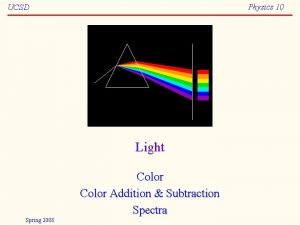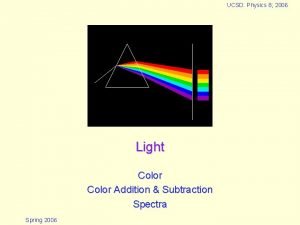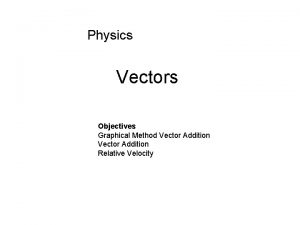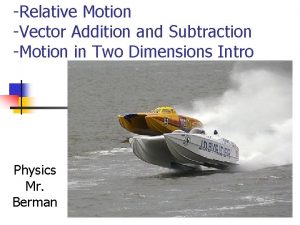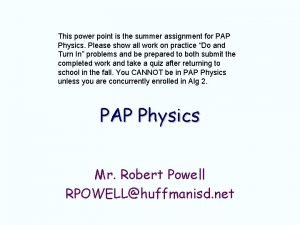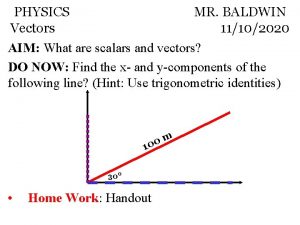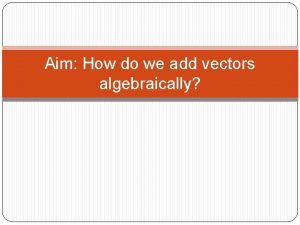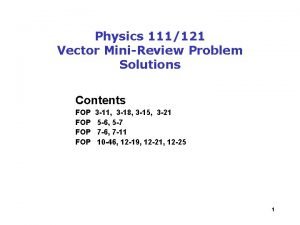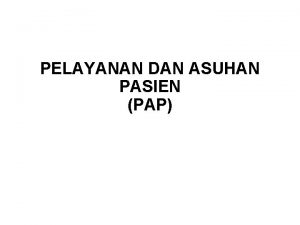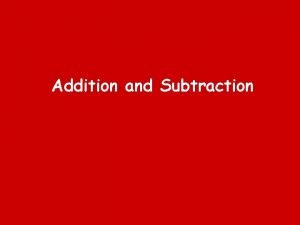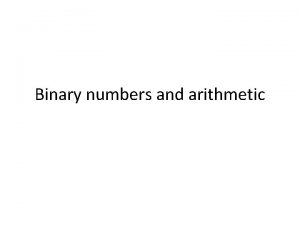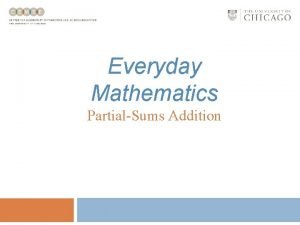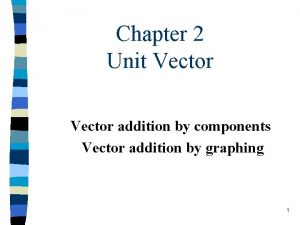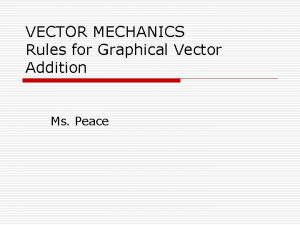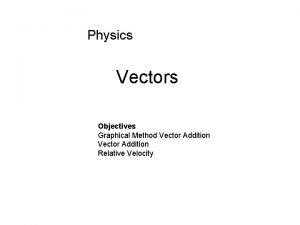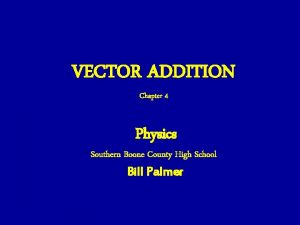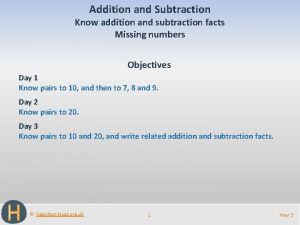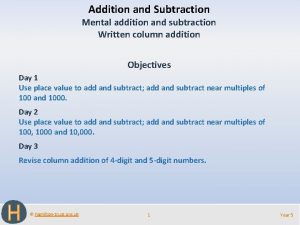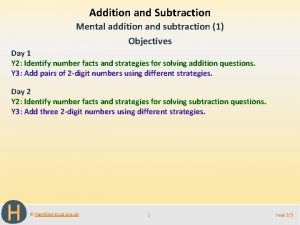PAP PHYSICS Vector And Vector Addition Vector n






























- Slides: 30

PAP PHYSICS Vector And Vector Addition

Vector n n n Is a measurable physical quantity that has both direction and magnitude The length is drawn to scale, it represents the size or magnitude The arrow points in the direction of the vector velocity, displacement, acceleration

This vector is only a few centimeters long but could represent a displacement vector of 200 meters.

Scalar Is a quantity that has magnitude only For example: Speed, time, mass, temperature, distance n

The Resultant n n Is the single vector that could represent the sum of several vectors It replaces the other vectors

n http: //www. walterfendt. de/ph 14 e/resultant. htm

Adding Vectors by the Graphical Method Steps: 1. Vectors are drawn to scale 2. Draw 1 st vector (at specific direction) 3. Draw 2 nd vector, tip-to-tail 4. Draw the resultant with a straight edge, from beginning to end. 5. Measure the resultant with a ruler 6. Measure the angle with a protractor


Example 1 n n A person walks 200 meters East, stops to rest and then walks another 400 meters East. Find the total displacement graphically.

Example 2 n n A person walks 200 meters East, stops to rest and then walks 400 meters West. Find the walker’s total displacement from the starting point.

Example 3 n n A person walks 95 meters East and turns and walks 55 meters North. Find their total displacement by the graphical method.

Example 4 n n Two forces are exerted on an object, one is 65 N at 0º and the second force is 45 N at 60º. Find the resultant by the graphical method.

Lab n Treasure Island

Vector Addition: Analytical Method n n n For right triangles, use the right triangle trig functions Sin θ = Cos θ = Tan θ = SOH CAH TOA n Pythagorean Theorem

Example 5 n n An Airplane flying toward 0º at 90 km/h is being blown toward 90º at 50 km/h. What is the resultant velocity of the plane?

Example 6 n An archaeologist climbs the Great Pyramid in Giza, Egypt. If the pyramid’s height is 136 m and its width is 2. 30 x 102 m, what are the magnitude and the direction of the archaeologist’s displacement while climbing from the bottom of the pyramid to the top?

Component Method of Vector Addition n n Remember, a resultant is the vector that replaces two or more vectors acting in various directions from the same point and are replaced by this single vector Components – any single vector can be broken down into two components The horizontal component (x) The vertical component (y)

n n The horizontal component (x) = A Cosθ The vertical component (y) = ASinθ

Example 7 n Find the horizontal and vertical components of the velocity of a helicopter traveling at 95 km/h at an angle of 35º to the ground.

Components Example: Spot the dog is pulling on his leash with 60. 0 N of force at an angle of 40° to the Horizontal. Find the vertical and horizontal components of this force.


Component Method of Vector Addition Steps: 1. Find the horizontal components of the vectors 2. Find the vertical components of the vectors 3. Sum the horizontal components 4. Sum the vertical components 5. Draw a right triangle using these sums

6. Use the Pythagorean theorem to find the resultant 7. Use Inverse tangent function to find the angle, the direction of the resultant vector

Example 8 n n n Two ropes are pulling on a fallen tree at the same time at the same point. One is 12 newtons at 10º and the other is 8 newtons at 120º. What is the net force on the fallen tree?

Another way to add vector that are NON -perpendicular Law of Sines a/Sin. Aº = b/Sin. Bº = c/Sin. Cº n Law of Cosinesc 2 = a 2 + b 2 - 2 ab Cos Cº n Do example 8 with law of sines and cosines instead of the component method. n

Example 9 n A hiker walks 25. 5 km from her base camp at 35º south of east. On the second day, she walks 41. 0 km in a direction of 65º north of east, at which point she discovers a forest ranger’s tower. Determine the magnitude and the direction of her resultant displacement between base camp and the ranger’s tower.

Relative Motion n n When adding vectors, we know that order does not matter, as long as you do not change the magnitude or direction of any single vector We also know that perpendicular vectors are independent of one another

Example 12 n n A motorboat heads East across a river at 8 m/s. The river flows South at 5 m/s and the river is 80. 0 m wide. What is the resultant velocity of the boat? How long does it take the boat to cross the river? How far down the river is the boat pushed?


 Vector resolution examples
Vector resolution examples Color addition and subtraction physics
Color addition and subtraction physics Color 82006
Color 82006 Directed line segment
Directed line segment Graphical vector addition
Graphical vector addition Vector addition
Vector addition Vector addition
Vector addition Components of a vector
Components of a vector Vector addition
Vector addition Graphical addition of vectors
Graphical addition of vectors How do you add two vectors algebraically
How do you add two vectors algebraically Abnormal pap and colposcopy
Abnormal pap and colposcopy A floating ice block is pushed through a displacement
A floating ice block is pushed through a displacement Why does it happen
Why does it happen University physics with modern physics fifteenth edition
University physics with modern physics fifteenth edition Physics ia ideas
Physics ia ideas Unified account code structure
Unified account code structure Corn pone opinions summary
Corn pone opinions summary Contoh penilaian acuan kriteria
Contoh penilaian acuan kriteria Cara menghitung pap
Cara menghitung pap Ayers speculum
Ayers speculum Schleife pap
Schleife pap Lcpe performance assessment
Lcpe performance assessment Datenflussplan symbole
Datenflussplan symbole Hi pap
Hi pap Hola papá te quiero mucho
Hola papá te quiero mucho Gymnasium papenburg
Gymnasium papenburg Bb shots in pap smear
Bb shots in pap smear Pap-mart reactivo para citología
Pap-mart reactivo para citología Pap 1
Pap 1 Estrutura da pap
Estrutura da pap

